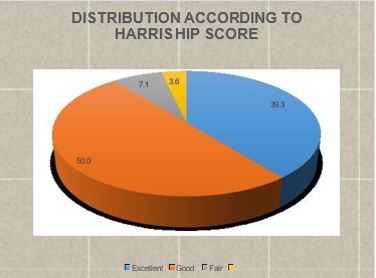Functional outcome of patients of intertrochanteric femur fracture treated with trochanteric fixation nail in elderly patients
Abstract
Background-Intertrochanteric fractures are disabling injuries in geriatric population and they are the most frequently operated fracture type which has the highest postoperative fatality rate of all surgically treated fractures. The objective of the study was to evaluate the functional outcomes of intertrochanteric fractures treated with trochanteric fixation nail (TFN) in elderly patients.
Method-This is a prospective and retrospective study with 30 patients of Intertrochanteric femur fractures carried out in the Department of Orthopaedics, Sri Aurobindo Medical College, and P.G. Institute, Indore from Jan 2015 to Aug 2020. Data collected according to Evan’s classification. Patients were followed up at intervals of 6 weeks,12 weeks,6 months and 12 months and final results were evaluated using Harris hip score at the end of 1 year.
Results -The study included 30 patients, 18 males, 12 females with mean age of 70.27 years (range: 65-85 years). The fracture union rate was 96% and average union time was 12.9 weeks. Our results were excellent (39.3), good (50%), fair (7.1%) and poor (3.6%). The most common complication encountered was Varus collapse and shortening seen in 4 (13.33%) patients, superficial wound infection in 2 patients (6.67%); Varus collapse and shortening and Z effect and screw revision was seen in 2 (6.67%) while Deep infection and secondary ‗Z‘ effect, Implant failure, Non-union, Knee stiffness in 1 patient each.
Conclusion-The treatment of intertrochanteric fractures with TFN had a more favourable outcome and it is the ideal implant of choice for intertrochanteric fractures at present.
Downloads
References
Abrahamsen B, van Staa T, Ariely R, et al. Excess mortality following hip fracture: Asystematic epidemiological review. Osteoporos Int. 2009;20(10):1633–1650.
Ahrengart L, Törnkvist H, Fornander P, et al. A randomized study of the compressionhip screw and Gamma nail in 426 fractures.ClinOrthopRelat Res. 2002;401:209–222.
Cummings SR, Nevitt MC.: ―A Hypothesis: The Causes of Hip Fractures‖; J Gerontol 1989; 44:107-111.
T.Lindner,N K Kanakaris,BMarx,Acockbain. ―Fracture of the hip and osteoporosis‖ Journal of bone and joint surgery,2009;91- B:294-303.
Dhiraj VS. Evans – classification of intertrochanteric fractures and their clinicalimportance. Trauma International 2015;1(1):7-11.
Tronzo RG. Use of extramedullary guide pin for fractures of the upper end of the femur. Orthop Clin North Am 1974;5(3):525-7.
Koval KJ, Aharonoff GB, Rokito AS, Lyon T, Zuckerman JD. Patients with femoral neck and intertrochanteric fractures. Are they the same? Clinical orthopaedics and related research. 1996; (330):166-72.
Bucholz RWH, James D, Court-Brown, Charles M. Tornetta, Paul. Rockwood and Green's Fractures in Adults, 7th Edition. Russell TA, editor. Philadelphia.
Windoff J, Hollander DA, Hakimi M, Linhart W (2005) Pitfalls and complications in the use of Trochanteric Fixation nail. Langenbecks Arch Surg 390(1):59–65, Feb Epub 2004 Apr 15.
Brammar TJ, Kendrew J, Khan RJ, Parker MJ (2005) Reverse obliquity and transverse fractures of the trochanteric region of the femur; a review of 101 cases. Injury 36(7): 851-857.
Herman A, Landau Y, Hazanov A, Segev T, Thein R, et al. (2013) Differencesin Survival Rates between Different Patterns of Unstable Pertrochanteric Femoral Fractures. OJO 3(6): 261-268.
Karn NK, Ashish Jain, Nepal P et al. A prospective randomized control trial comparing Trochanteric Fixation nail and sliding hip screw in the management of trochanteric fracture of the femur. Health Renaissance, January-April 2011; Vol9 (No.1). 7-11.
Pajarinen J, Lindahl J, Savolainen V, Michelsson O, Hirvensalo E. Femoral shaft medialisation and neck-shaft angle in unstable pertrochanteric femoral fractures. Int Orthop 2004;28:347–53.
Dousa P, et al. Osteosyntehsis of trochanteric fractures using TFN. Acta ChirOrhtopTraumatol Cech 2002;69(1):22-30.
Review paper by Kenneth. J. koval on IMN of proximal femur(A supplement to American jr of orthopaedics april 2007).
Egol KA Chang EY, Cvitkovic j, kummerFJ, KovalKJ.Mismatch of current IMN with the anterior bow of femur. J Orthop trauma2004;18(7):410-415.
The ―Z-Effect‖ Phenomenon Defined: A Laboratory Study Eric J. Strauss,1 frederick J. Kummer,1 Kenneth J. Koval,2 Kenneth A. Egol (journal of orthopaedic research 2007 doi 10.1002/jor).
Werner-Tutschku W, Lajtai G, Schmiedhuber G, Lang T, Pirkl C, Orthner E. Intra-and perioperative complications in the stabilization of per-and subtrochanteric femoral fractures by means of TFN. Unfallchirurg. 2002;105(10):881-5.
Dr. Justin Moses, Dr. Kalyan Deepak Sreenivas. A prospective study on outcomes of stainless steel proximal femoral nail for unstable intertrochantericfractures in rural population. International Journal of Orthopaedics Sciences 2020; 6(1): 379-382.
J. Li 1, L. Cheng1, J. Jing. The Asia proximal femoral nail antirotation versusthe standard proximal femoral antirotation nail for unstable intertrochanteric fractures in elderly Chinese patients. Orthopaedics & Traumatology: Surgery &Research 101 (2015) 143– 146.
Christian Boldin, Franz J Seibert, Florian Fankhauser, GeroifPeicha, WolfgangGrechenig and Rudolf Szyszkowitz. "The Trochanteric Fixation nail (TFN) - a minimal invasive treatment of unstable proximal femoral fractures Aprospective study of 55 patients with a follow-up of 15 months Acta OrthopScand 2003;74(1):53-58.

The entire contents of the Orthopaedic Journal of Madhya Pradesh Chapter are protected under Indian and International copyrights. Orthopaedic Journal of Madhya Pradesh Chapter allow authors to retain the copyrights of their papers without restrictions, Authors grant the publisher the right of exclusive publication. The Journal then grants to all users a free, irrevocable, worldwide, perpetual right of access to, and a license to copy, use, distribute, perform and display the work publicly and to make and distribute derivative works in any digital medium for any reasonable non-commercial purpose, subject to proper attribution of authorship. The journal also grants the right to make numbers of printed copies for their personal non-commercial use under Creative Commons Attribution-Non-commercial share alike 4.0 International Public License.

 OAI - Open Archives Initiative
OAI - Open Archives Initiative












